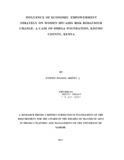| dc.description.abstract | This research project explores the influences of economic status and poverty on HIV/AIDs prevalence in Kisumu County. The research study was motivated by high levels of HIV I AIDs prevalence in area. It is believed that poverty levels and female vulnerability to economic means are at the heart of high incidences of female HIV / AIDS risk. It is a common belief that sexual behaviour change in Kisumu County can reverse the situation. An attempt to reduce the burden of the HIV AIDS pandemic and causes of HIV AIDS among women require multi-sectorial strategies and programmes that addresses poverty, gender inequalities and social marginalization must be supported as a key preventative component of anti AIDS strategy. Due to women's economic vulnerability and dependence on men, their ability to control the conditions like sexual abstinence, condom use and multiple sexual partners are constrained.
This shapes their risk of HIV infections and contributes to their high infection rates compared to men. It is believed that empowering women economically bring women and men to a near equitable relations at national, local and household levels. Women empowerment is urgently required to contain and reverse the AIDS epidemic. It is estimated that 7.4% of the population aged 15-64 are infected with HIV, majority being women 8.7% compared to men 5.6%. More women than men are getting infected and dying of HI V and AIDS by the day compared. Kisumu is one of the counties in Nyanza province with poverty incidence of 64%; slightly lower than the national levels of 65%. Compared to the '5.1 % national HIV burden, the region's HIV burden is placed at a prevalence of 11.2% .. Addressing the high HfV prevalence and poverty incidences in this region requires urgent and well targeted multi-sectoral approach.
The study was guided by four objectives; to what extend is saving programs as an aspect of economic empowerment strategy influence women HIV AIDS riskbehaviour change; to assess the level at which access to credit as an aspect of economic empowerment strategy influence women HIV AIDS risk behaviour change; what is the level at which business training as an aspect of economic empowerment strategy influence women HIV AIDS risk behaviour change; and to what extend does group partnership as an aspect of economic empowerment strategy influence women HIV AIDS risk behaviour change. The study explored crosssectional survey design. 36 women groups supported by Omega Foundation (an NGO based in Kisumu) formed the sample frame for this study. Simple random sampling technique was used to select 255 respondents out of the 762 total populations.
The researcher used structured questionnaire to collect data from the respondent. Data (From what sources)collected was reviewed and cleaned at collection point for 3 weeks. The data was analyzed using descriptive statistics and fmdings presented in tables. The study concluded that Economic empowerment has the potential to reduce the negative impact of AIDS on household economies through programs that foster savings and stimulate the development of Income-Generating Activities further The study recommendations to Government, NGO sectors and. other stakeholders; the study implementation of HIV/AIDS related projects and micro-finance projects that would support and improve on the women's income which is a source of their livelihood in the community. These programmes should focus on an attempt that would protect women's rights more so on property ownership and inheritance of assets. The study also recommended that women should be empowered to be economically empowered to decrease their vulnerability to HIV/AIDS risky behaviours. | en_US |

